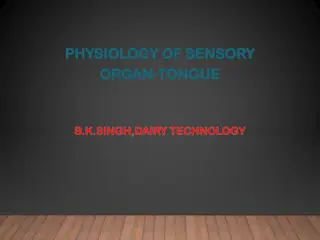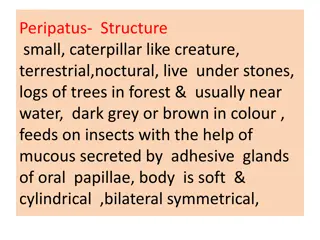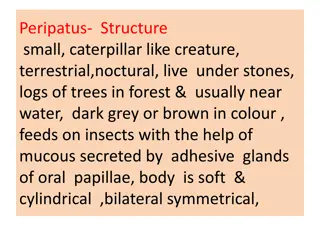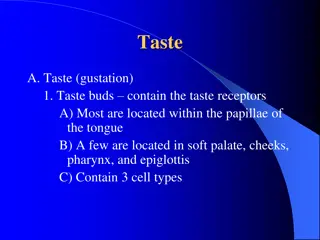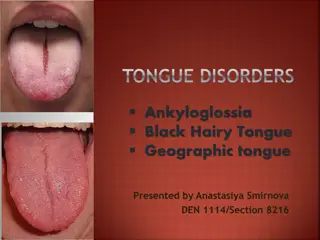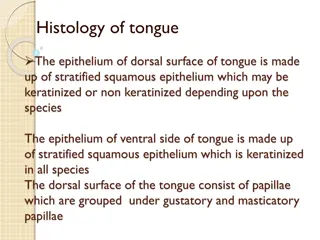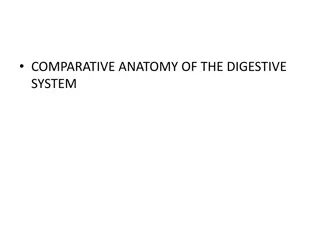Insect Abdominal Structures and Appendages: An Overview
The abdomen of insects plays crucial roles in respiration, reproduction, digestion, excretion, and metabolism. The number of abdominal segments varies across species, with reductions and modifications seen in different insect groups. From the propodeum to pregential and postgenital segments, each pa
1 views • 6 slides
Understanding the Physiology of the Sensory Organ - Tongue by B.K. Singh
Taste perception on the tongue is a vital sensory function involving sweet, sour, salty, and bitter sensations. The tongue, with its muscular movements and taste buds, plays a crucial role in mastication, swallowing, and food enjoyment. Different types of papillae on the tongue are responsible for t
4 views • 33 slides
Understanding Sensory Evaluation in Food Science
Sensory evaluation in food science involves analyzing human responses to the characteristics of food and beverages using the senses of sight, smell, taste, touch, and hearing. This scientific discipline aims to elicit, measure, analyze, and interpret reactions to the sensory attributes of food produ
0 views • 32 slides
Detailed Overview of Peripatus Structure and Anatomy
Peripatus, a small terrestrial nocturnal creature resembling a caterpillar, lives under stones and logs near water. Its body is cylindrical with indistinct segmentation and superficial ring-like annuli. The head features antennae, mandibles, and oral papillae, while the trunk bears walking legs with
2 views • 27 slides
Anatomy and Characteristics of Peripatus
Peripatus is a small, caterpillar-like terrestrial creature found in forests near water. It has dark grey or brown color, feeds on insects using mucous secreted by adhesive glands, and has a soft cylindrical body with bilateral symmetry. The body is divided into a head and trunk, with distinct featu
1 views • 27 slides
Understanding Taste: Gustation and Taste Receptors
Taste, also known as gustation, involves taste buds containing taste receptors that pick up sensations like salty, sweet, sour, bitter, and umami. These taste buds are mostly found on the tongue's papillae, with different types such as circumvallate, fungiform, and filiform papillae. Taste sensation
0 views • 53 slides
Understanding Tongue Disorders: Ankyloglossia, Black Hairy Tongue, Geographic Tongue
Ankyloglossia, also known as tongue-tied, is a congenital anomaly affecting tongue mobility. Black hairy tongue is the lengthening of papillae on the tongue surface, often temporary and resolve without treatment. Geographic tongue presents as white patches and is usually asymptomatic. Treatment opti
0 views • 10 slides
Anatomy of the Tongue: A Detailed Exploration
Squamous epithelium, striated muscle, and various types of papillae make up the intricate structure of the tongue. Filliform, fungiform, circumvallate, and foliate papillae play different roles in sensory perception and taste. Taste buds, Van Ebner's glands, and gustatory furrows add complexity to t
0 views • 40 slides
Histology of the Tongue: Structure and Function Overview
The tongue is covered by stratified squamous epithelium with various types of papillae on its dorsal surface, each serving specific functions such as taste perception and mechanical tasks. The filiform, fungiform, vallate, foliate, and circumvallate papillae are distinct in their appearance and dist
0 views • 10 slides
Overview of Comparative Anatomy of Digestive Systems and Dental Formulas in Various Animal Species
This content provides a detailed comparison of the digestive systems and dental formulas in different animal species including horses, ruminants, pigs, dogs, cats, and fowls. It delves into the unique characteristics of their tongues, papillae, soft and hard palates, as well as specific features lik
0 views • 22 slides

